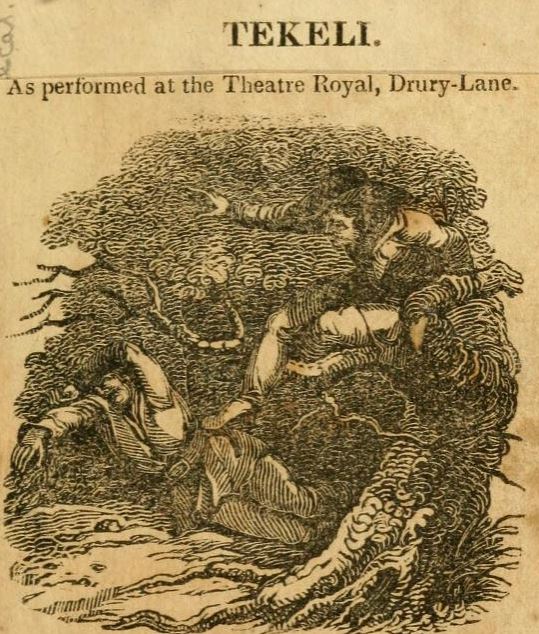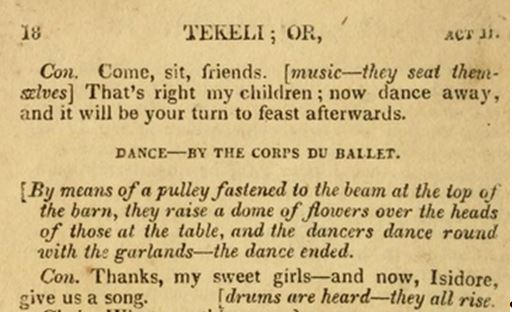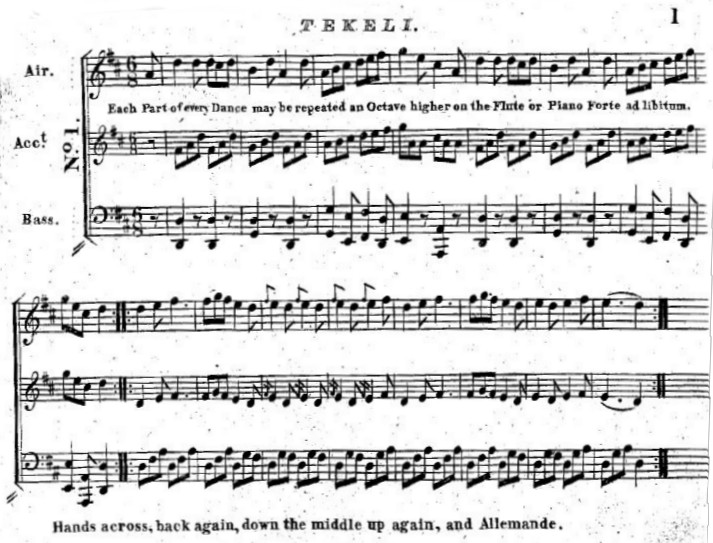Tekeli – a convict tune
Tekeli was an influential and highly successful melodrama, one of the first of its genre, full of suspense and intense emotions. The French play by Rene Charles Guilbert De Pixerécourt was produced in Paris in 1805 and an English adaptation was staged in London the following year. Music was integral to the play, creating atmosphere, introducing the characters, accompanying the action and dance, and punctuating the dialogue.

Tekeli at the Theatre Royal, Drury Lane featured an impressive grand cavalcade across mountains, which included model figures and animals that grew larger at each successive appearance—a primitive ‘special effect’.
Title page courtesy of the Internet Archive.
James Hook composed the music for the English version which so delighted audiences that it quickly spread throughout Britain, the colonies, and across the Atlantic. A number of the melodies became extremely popular – the signature tune Tekeli, the march, and the Pandean dance – and soon they began to appear in published collections of music and English country dances. The music was also transcribed into many personal tunebooks.
In Australia, the tune Tekeli made its way into the musical manuscript of the Scottish convict, Alexander Laing who arrived in Sydney in 1813, moving to Tasmania in 1815. Laing had been a soldier in the 92nd Gordon Highlanders before being convicted of theft and transported to the colony on the Marquis of Hastings. He was a talented Scottish fiddler and was probably familiar with the tune prior to arriving in the colony.

Advertisement for the Launceston Theatre’s production of Tekeli.
The Cornwall Chronicle (Launceston, Tas.)
National Library of Australia
However, another factor may have inspired Laing to include the tune in his collection, because in 1834 the play was staged in Tasmania. The Theatre Royal in Sydney had first introduced the celebrated drama to the colony which was “so well calculated to please the audience” that “no labour or expense spared” in its production. On opening night, Monday 31 March 1834, the play was “received by an overflowing house with the most unequivocal demonstrations of applause”.
The next year, the play made its Tasmanian premiere in the theatre at Launceston on 30 October with the advertisement claiming it was “never before performed in the colony”. Little is known about the theatre, though it can be assumed that some of the actors and musicians were convicts or ex-convicts.
In June 1836 the melodrama appeared on the stage of the Royal Victoria Theatre, Hobart and was reviewed in the True Colonist:
The first entertainment was TEKELI ; or, THE SIEGE OF MONTGATZ. We never had an opportunity of seeing this splendid spectacle in any of the London theatres, but really in Meredith’s little theatre the effect was astonishing from the admirable scenery and machinery, which he has got up as if by magic. We have not room this week to notice, the different performers, but we should be very unjust did we not say something about Mrs. Meredith, whose personification of “the Heroine of Montgatz,” and her delivery of the gallant and patriotic speeches in the part, afforded us so much satisfaction.
The music was grand — the singing very defective. Taylor, and Palmer played the disguised heroes well, but Palmer completely burlesqued the real Wolf : his attitudes were exactly those of “Bombastes Furioso.” The piece gave great satisfaction, and will, no doubt, continue to draw full houses until the whole play-going community have satisfied their curiosity by seeing the performance once or twice. True Colonist. (1836, June 3)
At the time, Laing was living in Sorrell, quite some distance from both Launceston and Hobart. It is unlikely that he attended a performance, however, the staging of the play would have brought the music to the public attention and no doubt, the audience went away whistling the catchy tunes. Theatre was the focal point of popular culture, supplying many of the songs and tunes which people took to their hearts and embraced as their own. A large proportion of tunes now regarded as traditional folk music came from 18th and 19th century theatre productions. Popular melodies quickly became widespread with transmission by published scores and by ear – musicians such as Laing, upon hearing the tune, would be able to play it by ear.
Music
Alexander Laing’s transcription of Tekeli.

Alexander Laing was a talented Scottish fiddler and composer, soldier, convict, and constable, whose music manuscript is significant as the only example of a convict music collection.
Tasmanian Archives
Recording by Roland Clarke
Dance
The melodrama included scenes with dancing, though only the briefest choreography was included:

A dance by the corps de ballet in Act II of Tekeli.
Image courtesy of the Internet Archive.
As well as balletic dances, the play seems to have included an English country dance or two – it was customary in the final act to bring the principle members of the cast to dance together, denoting the harmony achieved at the conclusion of drama. The the social character of the English country dance was perfectly suited for this purpose. Sometimes the dances performed in the play were adopted as popular social dances, and often new dances were devised to fit the tunes. The instructions for the English country dances Tekeli and the Pandean Dance in Tekeli appeared in many collections of dances published in England, Ireland, Scotland, and America. Both these dances were enjoyed at different levels of society from the Duchess of Richmond’s ball in Dublin Castle, through to rustic dances in Dorset where Thomas Hardy played.
Dances of this type were likewise enjoyed in the colony at splendid balls at Government House, and at the opposite end of the social scale: in disorderly houses where convicts frolicked illegally. Books of country dances were advertised for sale in the colony as early as 1803 and it’s likely the instructions for Tekeli were available by late 1808. One such book is Wheatstone’s Collection of Elegant and Fashionable Country Dances for the Ensuing Season 1808 which includes the music and instructions for Tekeli and the Pandean Dance from Tekeli. This was brought to the colony by the Woodriff family and is now in the National Library of Australia.

Score and dance instructions for Tekeli from A Selection of Elegant and Fashionable Country Dances for the Ensuing Season 1808.
National Library of Australia
The melodrama of Tekeli was renowned for its longevity throughout Britain and America in the 19th century; it was also staged in a number of locations around Australia including Adelaide and Geelong, and with repeat performances in Sydney and Hobart.
Links
An online version of the play is available from the Library of Congress via the Internet Archive https://archive.org/details/tekeli00hook/page/n5/mode/2up
An English version of the play from 1804 is held in the University of Sydney.
A French edition from 1815, Tekeli : le siege de Montgatz : melodrame historique, en trois actes, en prose, et a grand spectacle / par R. C. Guilbert Pixerecourt is held in the National Library of Australia.
A song from the play, The Garland of Love was performed at The Sydney Amateur Concert in the School Room, Old Court House, Castlereagh Street, Sydney on 27 September, 1826.
For a recording of the song visit The Garland of Love
References
Hibberd, S. (2015). Mélodrames ii: 1801–1803. French Studies, 70(1), 113-114. doi:10.1093/fs/knv268
Jordan, R. (2002). The convict theatres of early Australia 1788-1840. Strawberry Hills, NSW: Currency House.
Kuntz, A. (2009). The Fiddler’s Companion. http://www.ibiblio.org/fiddlers/TE.htm
Laing, A. (1863). Alexander Laing Music Manuscript Archives Office of Tasmania LINC Tasmania.
MacFie, P. H., Gadd, S., & Gadd, M. (2010). On the fiddle from Scotland to Tasmania, 1815-1863 : the life and music of Alexander Laing (1792-1868), convict, constable, fiddler and composer. Dulcot, Tasmania: Peter MacFie ; Franklin, Tas. : Steve and Marjorie Gadd.
Pisani, M. V. (2014). Music for the Melodramatic Theatre in Nineteenth-Century London and New York. Iowa City: University of Iowa Press.
Skinner, G. (2017). Australharmony: An online resource toward the history of music in colonial and early Federation Australia Retrieved 8 September 2016, from University of Sydney http://sydney.edu.au/paradisec/australharmony/#



2 Responses to Tekeli